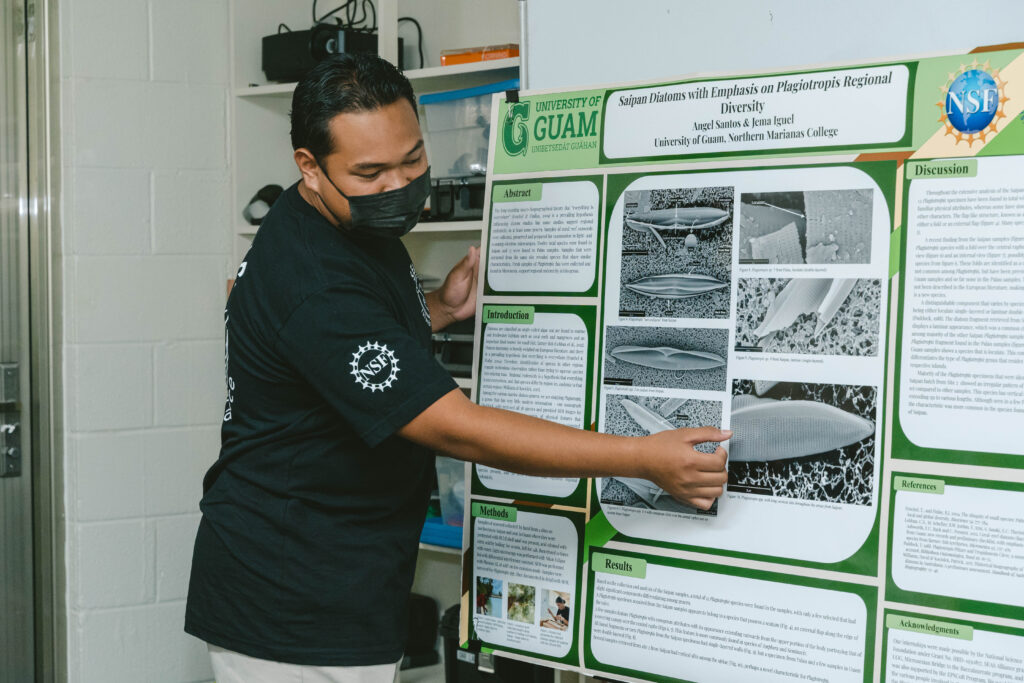
The Micronesia Summer Bridge to Bachelor’s Program culminated its 2022 cycle with a poster presentation by its summer interns in July at the University of Guam Microscopy Teaching & Research Laboratory. The presentations highlighted new species found in the Micronesia region.
The four students were the first batch of program interns to participate on-campus as the University eases its COVID-19 restrictions. Yuji Chibana and Rhiden Moreno from Palau Community College presented a poster on “Palau Mangrove and Coral Reef Diatoms with Emphasis on Gyrosigma Regional Diversity.” Meanwhile, Jemalynn Iguel and Angel Santos from the Northern Marianas College presented on “Saipan Diatoms with Emphasis on Plagiotropis Regional Diversity.”
Diatoms are single-celled algae found in oceans, lakes, and rivers. These microorganisms thrive in marine and freshwater habitats and produce 20 percent of the breathable oxygen on earth each year.
Chibana and Moreno worked on several samples taken from mangrove and coastal areas in Palau and Yap. Moreno said, “We found three species, two of which are new. This extends Palau’s library of Gyrosigmas from eight to ten.” The two species identified were the Gyrosigma variistriatum v2 and Gyrosigma bowtie.
Meanwhile, the Saipan team found 12 Plagiotropis species from specimens collected in Saipan and 17 species collected from Palau. According to Iguel, samples extracted from the same site revealed diatom species that share similar characteristics, which supported the theory of regional endemicity.
The students started their internship in June by gathering diatom and algae samples in several mangrove and coastal sites on Guam. The collected samples contributed to an ongoing diatom research supported by the National Science Foundation’s Established Program to Stimulate Competitive Research (EPSCoR).
Professor Emeritus of Biology Dr. Christopher Lobban and his team of EPSCoR and NSF INCLUDES SEAS Islands Alliance supported student researchers/mentors worked closely with the interns in analyzing the samples at the EPSCoR-funded lab. NSF EPSCoR Student Research Experience and NSF INCLUDES: SEAS Islands Alliance undergraduate student researchers Khazmyne Kawamoto and Monita Paul served as student mentors to the Saipan and Palau teams, respectively.
The overall research project seeks to determine and document the native diatom species in the region, especially on Guam, CNMI, Palau, FSM, and the Marshall Islands. “Basically, what we are trying to look for is to look for a signal for regional endemicity. So, we are looking at species that occur here but not in other places,” Dr. Lobban said in an earlier interview about the overall project.
The Micronesia Summer Bridge to Bachelor’s program offers opportunities to students from the Micronesian region who are interested in Science Technology Engineering and Mathematics (STEM) research. Participants of the program receive a $3,000 stipend; comprehensive research training; faculty and near-peer mentorship; and travel, lodging, and food accommodations for those traveling to Guam.
The UOG Center for Island Sustainability and UOG Sea Grant in partnership with the UOG School of Education oversees the program. It is funded by a grant from the National Science Foundation through UOG’s Inclusion Across the Nation of Communities of Learners of Underrepresented Discoverers in Engineering and Science (INCLUDES) Supporting Emerging Aquatic Scientists (SEAS) Islands Alliance Guam Hub.


